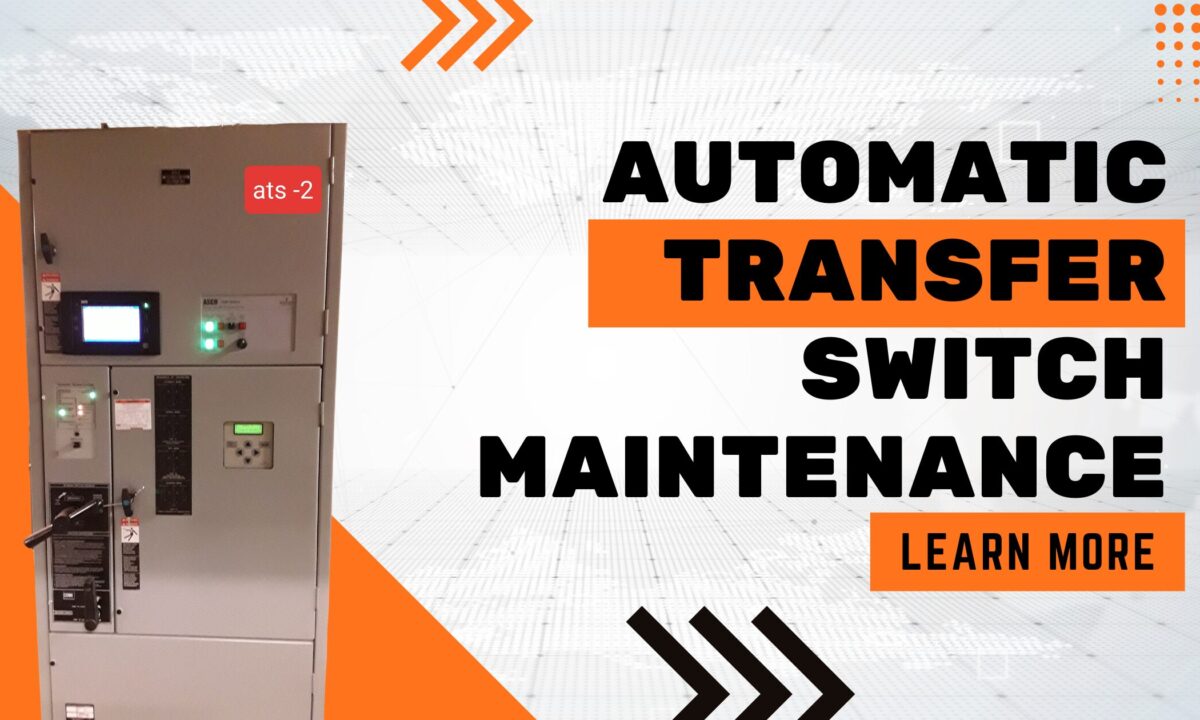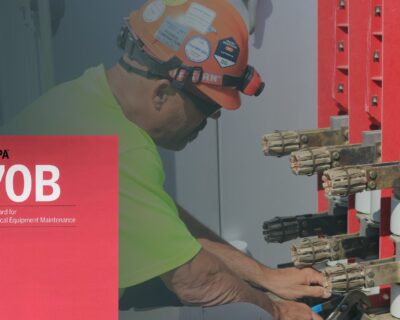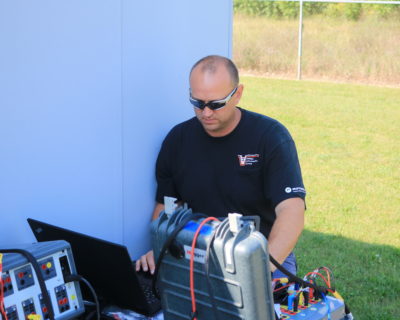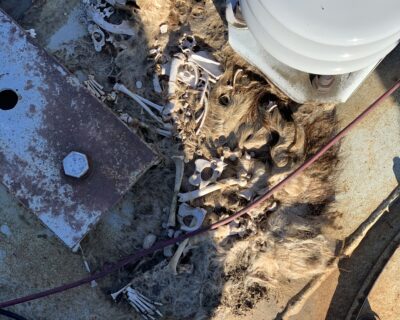Learn
Exploring the Risks of Automatic Transfer Switch Maintenance

The Critical Role of Automatic Transfer Switches (ATS)
In the dynamic landscape of facility management and electrical infrastructure, the Automatic Transfer Switch (ATS) stands as an unsung hero, quietly ensuring the seamless continuation of power supply during outages. Its critical role cannot be overstated, acting as the gatekeeper between uninterrupted operations and the chaos of unexpected power disruptions. However, the motto “out of sight, out of mind” often prevails, leading to a common oversight in the rigorous upkeep of these pivotal devices. This oversight neglects a fundamental truth: ensuring reliability with ATS preventive maintenance is not just a practice but a necessity for any facility prioritizing safety, efficiency, and operational continuity.
Automatic Transfer Switches are more than mere electrical components; they are the guards of electrical continuity, especially in environments where power is the lifeline for operational integrity. Imagine, a hospital during a critical surgical procedure or a data center processing millions of dollars in transactions. The sudden loss of power in these scenarios could have dire consequences. Here, the ATS leaps into action, swiftly transitioning to an alternate power source, often so seamlessly that the end-users remain blissfully unaware of the potential crisis averted.
Yet, despite their importance, the conversation around ATS often orbits its functionality, with scant attention paid to the nuanced demands of its maintenance. The industry talks about preventive maintenance in broad strokes, mentioning schedules and checklists. What is seldom considered, however, is the tailored approach required for ATS preventive maintenance, one that considers not just the mechanical wear and tear but also the unique operational context of each facility. It’s about understanding that each click of the ATS during a transfer is a testament to its reliability, reliability forged through diligent, anticipatory care.
Ensuring reliability with ATS preventive maintenance involves a deep dive into the symbiosis between the ATS and the facility it serves. It’s not just about keeping the lights on; it’s about understanding the ripple effects of power transitions, the nuances of load differences between primary and secondary sources, and the ATS’s role in mitigating potential power quality issues. This preventive stance is a strategic imperative, one that guards against the complacency of routine, challenging facilities to reconsider what reliability truly means in the context of their critical power systems.
Understanding Automatic Transfer Switches
Automatic Transfer Switches (ATS) are the cornerstone of a resilient electrical system, offering a seamless transition between power sources during outages. This section dives into the intricate architecture of ATS and underscores the importance of meticulous maintenance to uphold operational reliability.
Components and Functions
ATS systems are ingeniously designed to monitor the incoming power supply constantly. At the heart of its operation lies a robust mechanism that swiftly shifts power from the primary source to an emergency standby, ensuring a continuous power supply without interruption. This automatic switching capability is crucial in critical environments where even a brief power interruption can result in significant operational disruptions or safety hazards.
The Maintenance Imperative
Proper maintenance is the anchor in the operational integrity of ATS systems. As outlined in an insightful article on WeldPower, key steps in ATS maintenance include the use of the manual operator handle, which plays a pivotal role in revealing potential issues within the switch’s mechanisms. This procedure necessitates de-energizing both the primary and emergency power sources to ensure safety during the manual testing phase.
A thorough visual and mechanical inspection forms the backbone of effective ATS maintenance. This process involves checking for signs of wear, ensuring that electrical warning signs are correctly displayed, and verifying the correct phase rotation. Such meticulous inspections are vital in preempting failures and guaranteeing that the ATS can perform its critical function when needed most.
Essential Tests for Ensuring Functionality
The article further recommends conducting specific tests during the annual maintenance schedule. Contact and pole-resistance tests are paramount in assessing the switch’s functionality, ensuring that it can reliably perform its switching duties under real-world conditions. These tests are instrumental in diagnosing potential issues before they escalate into significant problems, thereby averting downtime and ensuring operational reliability.
The Role of Regular Maintenance
Regular maintenance transcends the mere functionality of ATS; it is about guaranteeing seamless power transitions during outages, thus preventing downtime. This encompasses proper cleaning, lubrication, and inspection of all components, tasks that significantly contribute to the longevity and efficiency of automatic transfer switches. Such preventive measures not only enhance the system’s reliability but also safeguard the investment by prolonging the equipment’s life span.
Understanding and maintaining Automatic Transfer Switches is not just about technical proficiency; it’s about recognizing their critical role in operational continuity and safety. Through diligent maintenance practices, as highlighted in the referenced article, facilities can ensure that their ATS systems remain reliable, efficient, and ready to respond to power disruptions, safeguarding their operations against the unforeseen.
The Risks of Neglecting ATS Maintenance
Neglecting the maintenance of Automatic Transfer Switches (ATS) can lead to a cascade of operational, safety, and financial risks. In environments where continuous power supply is pivotal for operational integrity, the repercussions of ATS neglect can be far-reaching. Below, we dive into the significant risks associated with overlooking ATS maintenance, underscoring the critical importance of regular upkeep.
Increased Risk of Power Outages
- Unplanned Downtime: The primary risk of neglecting ATS maintenance is the increased likelihood of unplanned power outages. An ATS in disrepair may fail to switch power sources during an outage, leading to sudden and prolonged downtime.
- Operational Disruption: For facilities that depend on continuous power, such as manufacturing plants or hospitals, the impact of unexpected downtime can disrupt operations, affecting productivity and compromising patient safety.
Safety Hazards
- Electrical Hazards: A malfunctioning ATS can pose serious electrical hazards, including the risk of fires, electrical shocks, and explosions. These risks not only endanger facility staff but can also lead to extensive property damage.
- Compliance Violations: Failing to maintain ATS systems can result in non-compliance with safety regulations, leading to legal ramifications and potential fines.
Equipment Damage and Repair Costs
- Costly Repairs: An ATS that fails due to lack of maintenance often requires extensive and costly repairs. In some cases, complete replacement may be necessary, significantly increasing operational costs.
- Shortened Equipment Lifespan: Regular maintenance extends the lifespan of an ATS. Neglect can accelerate wear and tear, leading to premature failure and the need for early replacement.
To illustrate, consider the following risks of neglecting ATS maintenance:
- Failure to Perform: Without regular maintenance, an ATS may fail to switch power sources during a critical need, resulting in operational downtime.
- Decreased Reliability: Over time, neglected ATS systems become less reliable, increasing the risk of unexpected failures and the costs associated with emergency repairs.
- Safety Compromises: The risk of electrical accidents increases with poorly maintained ATS systems, posing a direct threat to facility personnel and infrastructure.
- Increased Operational Costs: Frequent breakdowns and repairs due to maintenance neglect can lead to significant increases in operational expenses.
The maintenance of Automatic Transfer Switches is not a mere technical requirement but a strategic imperative for ensuring operational efficiency, safety, and financial stability. Facilities that prioritize ATS maintenance can avert the risks associated with neglect, safeguarding their operations against the unpredictable nature of power disruptions. By recognizing the critical role of ATS in their operational ecosystem, facility managers, electrical contractors, and engineers can take proactive steps to ensure their ATS systems are reliable, efficient, and ready to handle the demands of their operational environment.
Leveraging Expertise for ATS Maintenance
In the intricate world of electrical maintenance, the Automatic Transfer Switch (ATS) serves as a critical junction between a facility’s power supply and operational continuity. However, the complexity and significance of ATS systems necessitate a nuanced approach to their upkeep—one that leverages deep industry expertise. For facility managers, electrical contractors, electrical engineers, and NETA-certified technicians, understanding the value of expert intervention in ATS maintenance can be the difference between operational excellence and costly failure.
Choosing the Right Maintenance Partner
- Specialized Knowledge: Selecting a maintenance partner with specialized knowledge in ATS systems ensures that nuanced problems are identified and remedied before they escalate. This expertise is vital in understanding the unique requirements of different ATS models and configurations, which might not be apparent to generalists.
- Industry Certifications: A partner with industry certifications, such as NETA accreditation, provides assurance of their competence and adherence to the highest standards of electrical maintenance. These certifications are symbols of a commitment to excellence in electrical safety and reliability.
Training for In-House Teams
- Empowerment Through Knowledge: Regular training sessions for in-house teams on ATS maintenance can significantly enhance a facility’s resilience to power disruptions. This training should not only cover the technical aspects of maintenance but also emphasize the importance of preventive measures and the identification of early warning signs of ATS wear or failure.
- Customized Maintenance Protocols: Each facility has its unique operational demands and power requirements. Leveraging expertise means not just following a generic maintenance checklist but developing customized electrical maintenance plan that align with the specific needs and challenges of the facility.
Innovative Maintenance Strategies
- Predictive Maintenance: Moving beyond traditional preventive maintenance, leveraging expertise enables the implementation of predictive maintenance strategies. This approach uses data analytics and monitoring tools to predict potential failures before they occur, ensuring that maintenance efforts are both timely and effective.
- Remote Monitoring Solutions: Expert maintenance partners often bring to the table advanced solutions like remote monitoring of ATS performance. This technology allows for real-time insights into the system’s health, enabling proactive maintenance decisions and reducing the need for on-site inspections.
Building a Maintenance Culture
- Creating a Maintenance Mindset: Expertise in ATS maintenance isn’t just about technical skills; it’s also about fostering a maintenance culture within the facility. This involves regular discussions about the importance of maintenance, sharing success stories of preventive maintenance averting potential crises, and recognizing the contributions of team members in maintaining operational continuity.
- Continuous Improvement: Leveraging expertise means being in a constant state of learning and improvement. Maintenance strategies and protocols should evolve based on new insights, technological advancements, and feedback from maintenance activities. This dynamic approach ensures that facilities remain at the cutting edge of ATS maintenance best practices. Keep up to date on industry changes such as NFPA 70B.
Leveraging expertise for ATS maintenance transcends the mere execution of routine tasks. It involves a comprehensive strategy that integrates specialized knowledge, advanced technology, and a culture of continuous improvement. For facilities aiming to ensure reliability, safety, and operational efficiency, the expertise of seasoned professionals and a proactive approach to maintenance are invaluable assets. By prioritizing expert-driven ATS maintenance, facilities not only protect their operational integrity but also position themselves for sustainable growth and resilience in the face of power uncertainties.
Prioritizing ATS Maintenance for Facility Resilience
As we navigate the complexities of maintaining operational resilience in today’s demanding industrial landscapes, the role of the Automatic Transfer Switch (ATS) becomes clear. It is not merely a component of the electrical system but the backbone of uninterrupted service and safety. The journey through understanding, risks, expertise, and innovative strategies for ATS maintenance culminates in a singular, pivotal realization: the non-negotiable necessity of prioritizing ATS maintenance for facility resilience.
In the words of industry experts from WeldPower, “Regular maintenance is vital for automatic transfer switches to seamlessly transition power sources during outages, preventing downtime and ensuring operational reliability.” This statement encapsulates the essence of ATS maintenance—not as a routine task but as a critical safeguard against the unpredictable nature of power supply and demand.
Reflecting on Maintenance as a Pillar of Resilience
ATS maintenance is more than a technical obligation; it’s a strategic investment in the continuity and reliability of essential services. Facilities that underscore the importance of regular, comprehensive maintenance protocols not only mitigate the risks associated with power outages but also establish a foundation of operational excellence.
The Imperative of Expert Guidance
Leveraging the expertise of seasoned professionals, as discussed, transforms ATS maintenance from a challenge into an opportunity—an opportunity to enhance system reliability, extend equipment lifespan, and optimize operational efficiency. The knowledge and insights offered by experts enable facilities to tailor maintenance practices to their unique needs, ensuring that every action taken is a step towards greater resilience.
Cultivating a Proactive Maintenance Culture
A proactive approach to ATS maintenance is characterized by anticipation and preparedness. Facilities that embrace this ethos, guided by the detailed insights into manual operation handling, visual inspections, and component assessments, stand at the forefront of operational readiness. They are the ones who, even in the face of power uncertainties, remain steadfast, powered by the assurance of a well-maintained ATS.
Looking Ahead: The Path to Enhanced Facility Resilience
As we look towards the future, the path to enhanced facility resilience is marked by a commitment to ongoing ATS maintenance. This journey is not static but dynamic, evolving with technological advances, operational demands, and the ever-changing landscape of electrical safety standards. It is a path that demands vigilance, dedication, and a forward-thinking mindset.
In conclusion, prioritizing ATS maintenance is a declaration of a facility’s dedication to safety, reliability, and operational excellence. It is a commitment that goes beyond the immediate demands of power continuity, embracing a broader vision of resilience and preparedness. As facility managers, electrical contractors, engineers, and technicians, the responsibility to uphold this commitment is paramount. In doing so, we not only protect the present but also pave the way for a future where power disruptions no longer pose a threat to our operational integrity or safety standards. Let us then move forward, guided by the insights and strategies discussed, to ensure that our ATS systems—and by extension, our facilities—are not just maintained but truly resilient.






